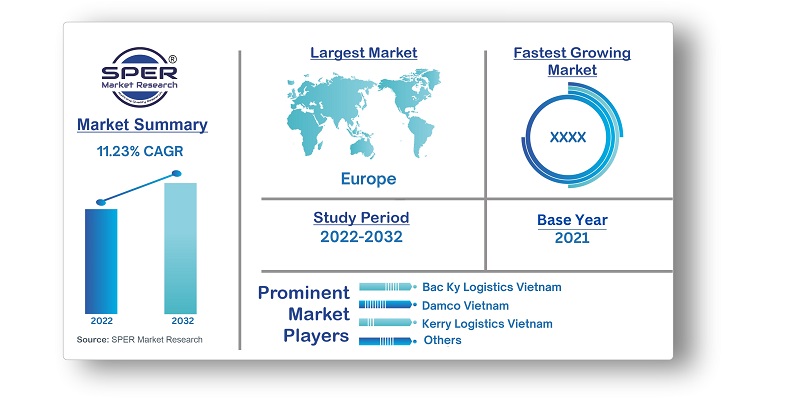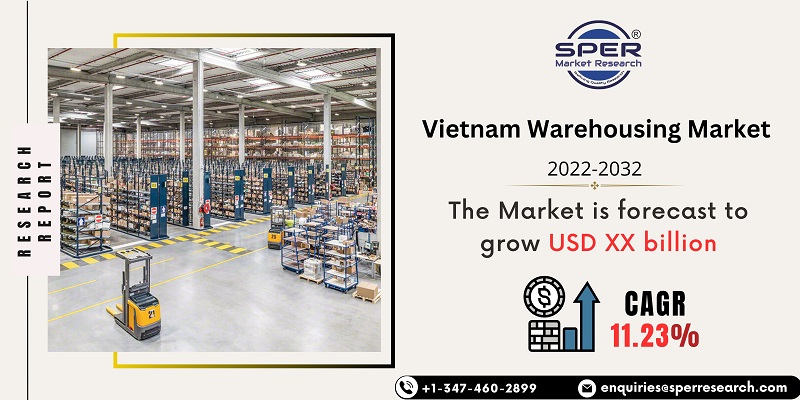
Vietnam Logistics and Warehousing Market Growth, Size, Trends, Revenue and Future Scope 2032
Vietnam Logistics and Warehousing Market Size-By Type, By Ownership, By End User- Regional Outlook, Competitive Strategies and Segment Forecast to 2032
| Published: Mar-2023 | Report ID: AMIN2329 | Pages: 1 - 102 | Formats*: |
| Category : Automotive & Transportation | |||
- Rising E-commerce Sector: The rapid growth of e-commerce has had a significant impact on Vietnam's logistics and warehousing business. The growing popularity of online shopping has increased demand for last-mile delivery services, fulfilment, centers, and effective inventory management systems. As a result, specialized logistics and warehousing solutions customized to the needs of the e-commerce sector have emerged.
- Government strategies: To promote the development of the logistics and warehousing sector, the Vietnamese government has developed supportive policies and measures. These include tax breaks, investment incentives for logistics infrastructure, and regulatory changes designed to make conducting business easier. Such policies have attracted both domestic and foreign investment, contributing to market expansion.

- The logistics and warehousing market in Vietnam has grown significantly in recent years, owing to a number of main factors. For starters, Vietnam's excellent economic performance and rapid industrialisation have resulted in a considerable need for effective logistics and warehousing solutions. The country has evolved as a manufacturing and export powerhouse, drawing foreign direct investment and establishing itself as a significant component in global supply chains. As a result, trade volumes have expanded, as has the demand for dependable transportation, distribution, and storage services.
- Firstly, limitations to infrastructure are a huge impediment. Despite continued advances, Vietnam's transportation network, which includes highways, trains, and ports, requires additional enhancements to meet the growing demands of the logistics sector. Inadequate infrastructure can cause congestion, delays, and increase operating costs for logistics providers.

| Report Metric | Details |
| Market size available for years | 2019-2032 |
| Base year considered | 2022 |
| Forecast period | 2022-2032 |
| Segments covered | By Type, By Ownership, By End User |
| Regions covered | Central Vietnam, North Vietnam, Southern Vietnam |
| Companies Covered | Bac Ky Logistics Vietnam, Damco Vietnam, Kerry Logistics Vietnam, Nippon Express Vietnam, Noi Bai Cargo Terminal Services, Sea and Air Freight International, Sotrans Vietnam, Transimex Saigon Corporation, Vinafco, Vinalink Logistics |
- Logistics and Transportation
- E-Commerce Companies
- Manufacturing Companies
- Retailers
- Government Agencies
- Real Estate Developers
- Investors
| By Type: |
|
| By Ownership: |
|
| By End User: |
|
- Vietnam Logistics and Warehousing Market Size (FY’2022-FY’2032)
- Overview of Vietnam Logistics and Warehousing Market
- Segmentation of Vietnam Logistics and Warehousing Market By Type (Cold Storage Warehousing, General Warehousing, Others)
- Segmentation of Vietnam Logistics Warehousing Market By Ownership (Bonded Warehouses, Non-Bonded Warehouses, Others)
- Segmentation of Vietnam Logistics Warehousing Market By End User (Chemicals, Consumer Goods, Food and Beverage, Healthcare, Retail, Textile and Footwear, Wooden Products, Others)
- Statistical Snap of Vietnam Logistics and Warehousing Market
- Expansion Analysis of Vietnam Logistics and Warehousing Market
- Problems and Obstacles in Vietnam Logistics and Warehousing Market
- Competitive Landscape in the Vietnam Logistics and Warehousing Market
- Impact of COVID-19 and Demonetization on Vietnam Logistics and Warehousing Market
- Details on Current Investment in Vietnam Logistics and Warehousing Market
- Competitive Analysis of Vietnam Logistics and Warehousing Market
- Prominent Players in the Vietnam Logistics and Warehousing Market
- SWOT Analysis of Vietnam Logistics and Warehousing Market
- Vietnam Logistics and Warehousing Market Future Outlook and Projections (FY’2022-FY’2032)
- Recommendations from Analyst
1.1. Scope of the report1.2. Market segment analysis
2.1 Research data source
2.1.1 Secondary data2.1.2 Primary data2.1.3 SPER’s internal database2.1.4 Premium insight from KOL’s
2.2 Market size estimation
2.2.1 Top-down and Bottom-up approach
2.3 Data triangulation
4.1. Driver, Restraint, Opportunity and Challenges analysis
4.1.1 Drivers4.1.2 Restraints4.1.3 Opportunities4.1.4 Challenges
4.2. COVID-19 Impacts of the Vietnam Warehousing Market
5.1. SWOT analysis
5.1.1 Strengths5.1.2 Weaknesses5.1.3 Opportunities5.1.4 Threats
5.2. PESTEL analysis
5.2.1 Political landscape5.2.2 Economic landscape5.2.3 Social landscape5.2.4 Technological landscape5.2.5 Environmental landscape5.2.6 Legal landscape
5.3. PORTER’S five forces analysis
5.3.1 Bargaining power of suppliers5.3.2 Bargaining power of Buyers5.3.3 Threat of Substitute5.3.4 Threat of new entrant5.3.5 Competitive rivalry
5.4. Heat map analysis
6.1 Vietnam Warehousing Manufacturing Base Distribution, Sales Area, Product Type6.2 Mergers & Acquisitions, Partnerships, Product Launch, and Collaboration in Vietnam Warehousing Market
7.1 Cold Storage Warehousing7.2 General Warehousing7.3 Others
8.1 Bonded Warehouses8.2 Non-Bonded Warehouses8.3 Others
9.1 Chemicals9.2 Consumer Goods9.3 Food and Beverage9.4 Healthcare9.5 Retail9.6 Textile and Footwear9.7 Wooden Products9.8 Others
10.1 Vietnam Warehousing Size and Market Share by Region (2019-2025)10.2 Vietnam Warehousing Size and Market Share by Region (2026-2032)10.3 Central Vietnam10.4 North Vietnam10.5 Southern Vietnam
11.1 Bac Ky Logistics Vietnam
11.1.1 Company details11.1.2 Financial outlook11.1.3 Product summary11.1.4 Recent developments
11.2 Damco Vietnam
11.2.1 Company details11.2.2 Financial outlook11.2.3 Product summary11.2.4 Recent developments
11.3 Kerry Logistics Vietnam
11.3.1 Company details11.3.2 Financial outlook11.3.3 Product summary11.3.4 Recent developments
11.4 Nippon Express Vietnam
11.4.1 Company details11.4.2 Financial outlook11.4.3 Product summary11.4.4 Recent developments
11.5 Noi Bai Cargo Terminal Services
11.5.1 Company details11.5.2 Financial outlook11.5.3 Product summary11.5.4 Recent developments
11.6 Sea and Air Freight International
11.6.1 Company details11.6.2 Financial outlook11.6.3 Product summary11.6.4 Recent developments
11.7 Sotrans Vietnam
11.7.1 Company details11.7.2 Financial outlook11.7.3 Product summary11.7.4 Recent developments
11.8 Transimex Saigon Corporation
11.8.1 Company details11.8.2 Financial outlook11.8.3 Product summary11.8.4 Recent developments
11.9 Vinafco
11.9.1 Company details11.9.2 Financial outlook11.9.3 Product summary11.9.4 Recent developments
11.10 Vinalink Logistics
11.10.1 Company details11.10.2 Financial outlook11.10.3 Product summary11.10.4 Recent developments
SPER Market Research’s methodology uses great emphasis on primary research to ensure that the market intelligence insights are up to date, reliable and accurate. Primary interviews are done with players involved in each phase of a supply chain to analyze the market forecasting. The secondary research method is used to help you fully understand how the future markets and the spending patterns look likes.
The report is based on in-depth qualitative and quantitative analysis of the Product Market. The quantitative analysis involves the application of various projection and sampling techniques. The qualitative analysis involves primary interviews, surveys, and vendor briefings. The data gathered as a result of these processes are validated through experts opinion. Our research methodology entails an ideal mixture of primary and secondary initiatives.



Frequently Asked Questions About This Report
PLACE AN ORDER
Year End Discount
Sample Report
Pre-Purchase Inquiry
NEED CUSTOMIZATION?
Request CustomizationCALL OR EMAIL US
100% Secure Payment






Related Reports
Our Global Clients
Our data-driven insights have influenced the strategy of 200+ reputed companies across the globe.




















